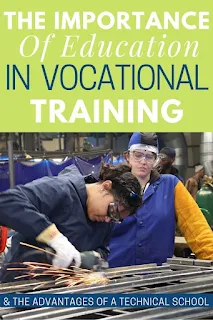.
Should Vocational Training Be a Compulsory Part of School Education in 2025?
In 2025, the educational landscape is evolving faster than ever. As the job market becomes more dynamic and skills-focused, a pressing question arises: Should vocational training be a compulsory part of school education? With employers increasingly valuing hands-on experience and job-ready abilities, integrating vocational training in schools is becoming more than just an option—it could be a necessity.
Bridging the Gap Between Education and Employment
Traditional education has long prioritised academic subjects like mathematics, literature, and science. However, many students leave school lacking practical skills for the real world. Introducing vocational training in schools helps bridge this critical gap. Students can explore trades such as plumbing, carpentry, coding, or graphic design, offering a direct path to employment and reducing the disconnect between school and the job market.
Reducing Youth Unemployment
One of the biggest challenges faced by countries globally is youth unemployment. By making vocational training in schools compulsory, students are equipped with tangible skills that can lead to immediate employment after graduation. This shift can reduce dependence on higher education as the only path to success, making employment opportunities more accessible for all social groups.
Aiding Students with Different Learning Styles
Not every student thrives in a traditional classroom environment. Some are visual learners, others are kinesthetic—they learn by doing. Vocational training in schools caters to diverse learning styles, allowing students to experience a more engaging and hands-on approach to education. This not only improves academic performance but also boosts confidence and interest in learning.
Supporting Economic Growth
A skilled workforce is the backbone of a strong economy. With industries like manufacturing, construction, and healthcare in constant demand for trained professionals, vocational training in schools plays a vital role in preparing future workers. When students graduate with job-ready skills, the transition into the workforce becomes seamless, which in turn supports economic development at both local and national levels.
Encouraging Entrepreneurial Thinking
In today’s gig economy, entrepreneurship is thriving. When vocational training in schools is part of the curriculum, students are introduced to business ideas, freelancing opportunities, and self-employment options early on. Whether it's learning how to start a carpentry business or becoming a freelance web designer, vocational skills can lay the foundation for independent career paths.
Addressing the Skills Shortage
Many industries are facing a significant skills shortage, especially in technical and trade sectors. By incorporating vocational training in schools, we ensure a steady pipeline of skilled individuals ready to fill these gaps. Countries like Germany have long championed this approach, resulting in lower unemployment rates and a more balanced workforce.
Promoting Equality in Education
Making vocational training in schools compulsory can also promote educational equality. It provides students from all backgrounds the opportunity to access high-quality training and job prospects, regardless of whether they pursue university education. This inclusive model ensures that talent and potential are not lost due to socioeconomic barriers.
Enhancing Soft Skills and Work Ethics
Beyond technical skills, vocational training in schools also teaches essential soft skills such as teamwork, communication, time management, and problem-solving. These attributes are highly valued by employers across all sectors. Moreover, students develop a strong work ethic and an understanding of professional expectations, giving them a competitive edge.
Integrating Modern Technology and Innovation
Vocational programmes in 2025 are not limited to traditional trades. With advancements in technology, vocational training in schools now includes areas like digital marketing, AI programming, drone operation, and renewable energy systems. These modern courses prepare students for futuristic job roles and ensure they remain relevant in a tech-driven economy.
Making Education More Purpose-Driven
Many students today feel that school education lacks purpose or relevance to their lives. By embedding vocational training in schools, we bring practicality and direction to the curriculum. Students can see the value of what they are learning and how it applies to their future careers, which increases motivation and reduces dropout rates.
A Pathway to Higher Education and Career Flexibility
Contrary to the belief that vocational training limits future choices, it often opens up new doors. Students who undergo vocational training in schools can still pursue higher education later, but they do so with real-world experience and clarity about their career goals. Additionally, having a trade or skill offers career flexibility and job security during economic downturns.
Challenges to Consider
While the benefits are clear, there are also challenges in making vocational training in schools compulsory. It requires investment in infrastructure, trained instructors, and curriculum redesign. Schools may need to collaborate with industries and private companies to provide real-world training. Despite these hurdles, the long-term benefits far outweigh the initial costs.
Global Examples and Best Practices
Countries like Switzerland and Finland have successfully integrated vocational training in schools. In these nations, students often split their time between classroom learning and industry apprenticeships. This dual education model provides practical experience while still maintaining academic standards. Learning from these systems can help shape a successful implementation strategy elsewhere.
Parental and Societal Acceptance
Changing the perception that vocational education is inferior to academic learning is crucial. Parents and communities need to be informed about the real value of vocational training in schools. Through awareness campaigns and success stories, society can begin to appreciate vocational education as an equal, if not superior, alternative in many cases.
Conclusion: A Step Toward a Smarter Education System
In conclusion, making vocational training in schools a compulsory part of education in 2025 is a forward-thinking move. It equips students with employable skills, enhances academic engagement, reduces unemployment, and contributes to a more balanced and inclusive society. As the world continues to evolve, so too must our education system—by blending academic knowledge with practical experience, we can better prepare the next generation for the real world.
Let me know if you’d like a version tailored for a specific audience (parents, educators, students, etc.), or if you want this turned into a social media carousel or newsletter format!




